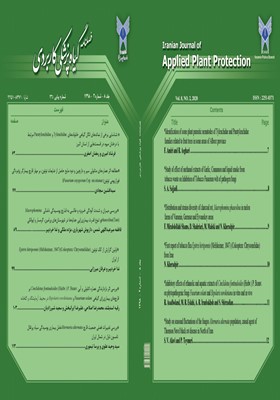مطالعۀ اثر عصارههای متانولی سیر و دارچین و دود مایع حاصل از ضایعات توتون، بر مهار قارچ بیمارگر پژمردگی فوزاریومی توتون(Fusarium oxysporum f.sp. nicotianae)
محورهای موضوعی : آفات گیاهی
1 - بخش گیاه پزشکی مرکز تحقیقات و آموزش تیرتاش
کلید واژه: عصاره گیاهی, زیستسنجی, پژمردگی فوزاریومی توتون, Fusarium oxysporum f.sp. nicotianae,
چکیده مقاله :
قارچ بیمارگرعامل پژمردگی فوزاریومی توتون از عوامل مهم بیماریزای گیاهی می باشد که در تمام نقاط دنیا پراکنده بوده و می تواند موجب خسارت محصول در کشور های تولید کننده توتون گردد. مدیریت این عامل بیماریزا با استفاده از سموم شیمیایی، استفاده ارقام مقاوم، کنترل بیولوژیک و همچنین استفاده از عصارههای گیاهی انجام میشود. به دلیل هزینه بالای مبارزه شیمیایی و آلودگی های زیست محیطی ناشی از آن، عصارههای گیاهی برای مدیریت این عامل بیماری ارجحیت دارند. این تحقیق با هدف بررسی اثر بازدارندگی عصارههای متانولیسیر و دارچین و دودمایع حاصل از ضایعات توتونبر رشد قارچ بیمارگرپژمردگی فوزاریومی توتون در آزمایشگاه و انتخاب غلظت مناسب در مرکز تحقیقات و آموزش تیرتاش در سال 1397 انجام شد. عصاره گیری از گیاهان سیر و دارچین با استفاده از حلال متانول انجام شد و همچنین از دود مایع حاصل از پیرولیز ضایعات توتون استفاده شد. ضایعات توتون در کوره در شرایط بدون اکسیژن پیرولیز شدند و دود حاصل با استفاده از آب سرد، خنک شده و تبدیل به دود مایع گردید. آزمایش به صورت فاکتوریل در قالب طرح کاملاً تصادفی با دو تیمار و سه تکرار انجام شد. تیمار اول عصاره گیاهی شامل سه گونه گیاهی (سیر، توتون و دارچین) و عامل دوم غلظت در شش سطح (0، 250، 500، 1000، 2000 و 4000 پی پی ام) در نظر گرفته شد. بررسی بازدارندگی عصارههای گیاهی با استفاده از روش اختلاط با محیط کشت انجام شد. نتایج نشان داد که عصاره گیاهان سیر و دارچین و دود مایع (توتون) اثر بازدارندگی خوبی بر رشد قارچ مورد بررسی در این مطالعه داشتند. با افزایش غلظت عصارههای گیاهی، اثر بازدارندگی روی رشد میسیلیومی قارچ بیمارگر پژمردگی فوزاریومی توتونافزایش یافت. حداقل غلظت بازدارندگی دود مایع حاصل از ضایعات توتون و عصاره متانولی سیر و دارچین بر قارچ عامل بیماری به ترتیب 2000، 4000 و 4000 پی پی ام بود. دود مایع ضایعات توتون در غلظت های بیشتر از 2000 پی پی ام دارای اثر قارچ کشی و عصاره متانولی سیر و دارچین در غلظت های بیشتر از 4000 پی پی ام دارای اثر قارچ ایستایی بودند.
Tobacco Fusarium wilts of pathogen fungi are important phytopathogens distributed worldwide and can cause yield losses in tobacco growing countries. The management of fungal soilborne pathogens are accomplished through the use of pesticides, resistant varieties, biological control, and use of plant extracts is done. The use of plant extracts for management of this disease is preferable because pesticides are expensive and may pollute the environment. This design investigated the inhibitory effects of some medicinal plant extracts on growth of Fusarium oxysporum f. sp. nicotianae the cause of tobacco collar rot and selection of a suitable concentration is performed in the laboratory in Tirtash Research and Education Center in 2018. The plants (Garlic and Cinnamon) were extracted with methanol and liquid smoke used in this study was obtained from the pyrolysis of tobacco waste. Tobacco waste was pyrolyzed in furnace in the absence of oxygen and smoke was converted to liquid smoke with cold water. This study were carried out in factorial with three factors including: crude extracts (Garlic, Cinnamon and Tobacco waste) and 6 concentration (0, 250, 500, 1000, 2000 and 4000 ppm) based on Completely Randomized Design with 3 replications. The minimum inhibitory concentration of each extracts was determined by agar diffusion method. Results indicated that crude extracts of Garlic, Cinnamon and Tobacco waste (liquid smoke) have remarkable antifungal activity. With increasing concentrations of plant extracts, inhibitory effect on mycelium growth of fungal F. o f. sp. nicotianae increased. The minimum inhibitory concentration of liquid smoke of tobacco waste and methanol extracts of Garlic and Cinnamon on tobacco Fusarium wilt of against fungiwere equal to 2000, 4000 and 4000 ppm, respectively. The liquid smoke of tobacco waste at concentrations greater than 2000 ppm has fungicide and methanol extracts of Garlic and Cinnamon at concentrations greater than 4000 ppm has fungistate.
_||_

